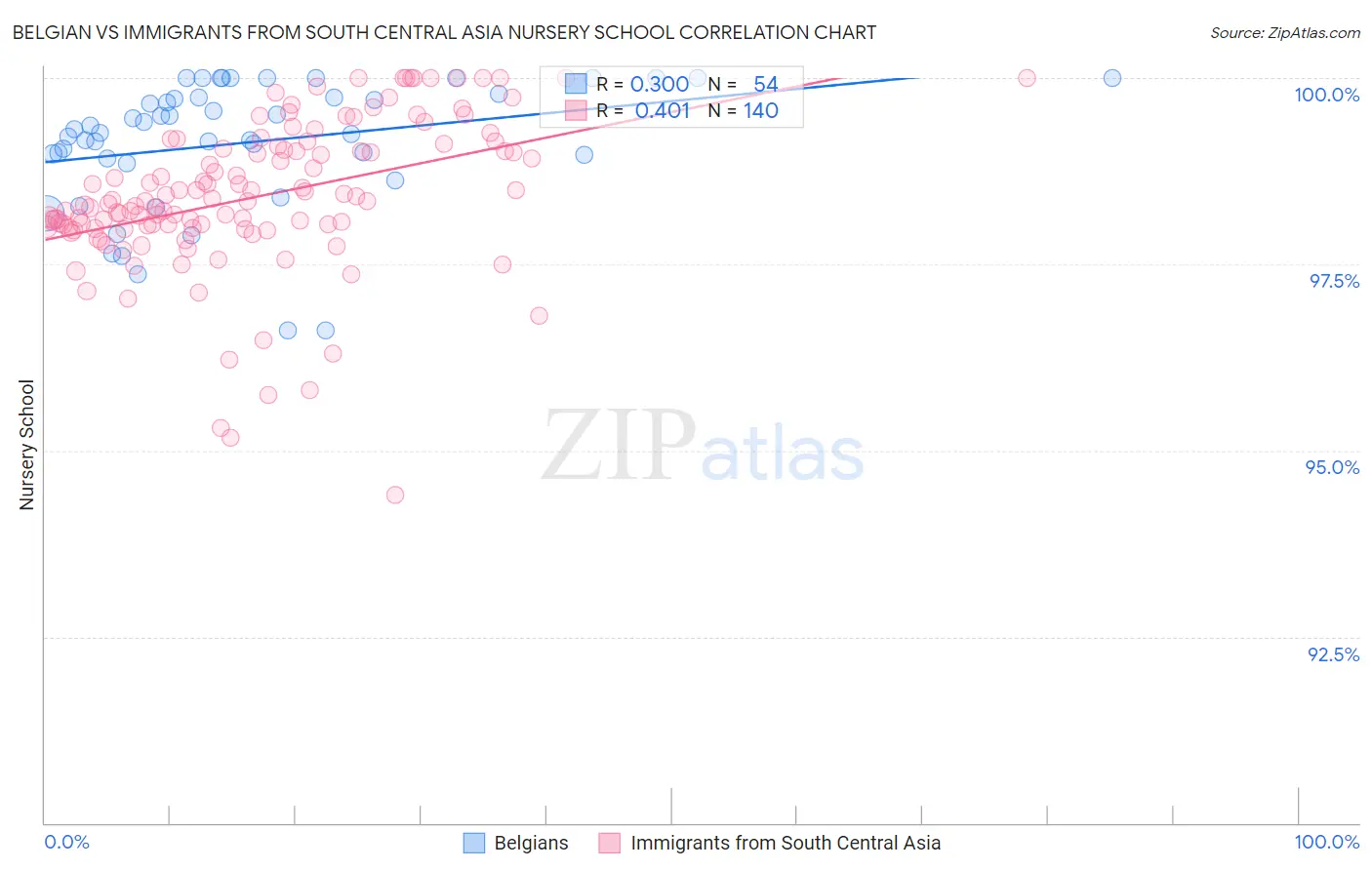Belgian vs Immigrants from South Central Asia Nursery School
COMPARE
Belgian
Immigrants from South Central Asia
Nursery School
Nursery School Comparison
Belgians
Immigrants from South Central Asia
98.5%
NURSERY SCHOOL
99.9/ 100
METRIC RATING
44th/ 347
METRIC RANK
98.0%
NURSERY SCHOOL
66.7/ 100
METRIC RATING
155th/ 347
METRIC RANK
Belgian vs Immigrants from South Central Asia Nursery School Correlation Chart
The statistical analysis conducted on geographies consisting of 356,016,627 people shows a weak positive correlation between the proportion of Belgians and percentage of population with at least nursery school education in the United States with a correlation coefficient (R) of 0.300 and weighted average of 98.5%. Similarly, the statistical analysis conducted on geographies consisting of 473,113,181 people shows a moderate positive correlation between the proportion of Immigrants from South Central Asia and percentage of population with at least nursery school education in the United States with a correlation coefficient (R) of 0.401 and weighted average of 98.0%, a difference of 0.47%.

Nursery School Correlation Summary
| Measurement | Belgian | Immigrants from South Central Asia |
| Minimum | 96.6% | 94.4% |
| Maximum | 100.0% | 100.0% |
| Range | 3.4% | 5.6% |
| Mean | 99.1% | 98.4% |
| Median | 99.3% | 98.3% |
| Interquartile 25% (IQ1) | 98.9% | 98.0% |
| Interquartile 75% (IQ3) | 99.7% | 99.1% |
| Interquartile Range (IQR) | 0.82% | 1.1% |
| Standard Deviation (Sample) | 0.86% | 1.0% |
| Standard Deviation (Population) | 0.85% | 1.0% |
Similar Demographics by Nursery School
Demographics Similar to Belgians by Nursery School
In terms of nursery school, the demographic groups most similar to Belgians are Northern European (98.5%, a difference of 0.0%), Luxembourger (98.5%, a difference of 0.010%), Eastern European (98.5%, a difference of 0.010%), Native Hawaiian (98.5%, a difference of 0.010%), and Latvian (98.5%, a difference of 0.020%).
| Demographics | Rating | Rank | Nursery School |
| Lumbee | 99.9 /100 | #37 | Exceptional 98.5% |
| Italians | 99.9 /100 | #38 | Exceptional 98.5% |
| Latvians | 99.9 /100 | #39 | Exceptional 98.5% |
| Chippewa | 99.9 /100 | #40 | Exceptional 98.5% |
| Luxembourgers | 99.9 /100 | #41 | Exceptional 98.5% |
| Eastern Europeans | 99.9 /100 | #42 | Exceptional 98.5% |
| Native Hawaiians | 99.9 /100 | #43 | Exceptional 98.5% |
| Belgians | 99.9 /100 | #44 | Exceptional 98.5% |
| Northern Europeans | 99.9 /100 | #45 | Exceptional 98.5% |
| Hungarians | 99.9 /100 | #46 | Exceptional 98.5% |
| Czechoslovakians | 99.9 /100 | #47 | Exceptional 98.5% |
| Ottawa | 99.8 /100 | #48 | Exceptional 98.5% |
| Whites/Caucasians | 99.8 /100 | #49 | Exceptional 98.5% |
| Celtics | 99.8 /100 | #50 | Exceptional 98.5% |
| Estonians | 99.8 /100 | #51 | Exceptional 98.5% |
Demographics Similar to Immigrants from South Central Asia by Nursery School
In terms of nursery school, the demographic groups most similar to Immigrants from South Central Asia are Venezuelan (98.0%, a difference of 0.0%), Comanche (98.0%, a difference of 0.0%), Immigrants from North Macedonia (98.0%, a difference of 0.0%), Dutch West Indian (98.0%, a difference of 0.010%), and Immigrants from Moldova (98.0%, a difference of 0.010%).
| Demographics | Rating | Rank | Nursery School |
| Immigrants | Greece | 75.4 /100 | #148 | Good 98.1% |
| Apache | 73.2 /100 | #149 | Good 98.1% |
| Jordanians | 72.9 /100 | #150 | Good 98.1% |
| Soviet Union | 71.6 /100 | #151 | Good 98.0% |
| Dutch West Indians | 70.2 /100 | #152 | Good 98.0% |
| Immigrants | Moldova | 69.6 /100 | #153 | Good 98.0% |
| Immigrants | Iran | 68.7 /100 | #154 | Good 98.0% |
| Immigrants | South Central Asia | 66.7 /100 | #155 | Good 98.0% |
| Venezuelans | 66.6 /100 | #156 | Good 98.0% |
| Comanche | 66.0 /100 | #157 | Good 98.0% |
| Immigrants | North Macedonia | 65.7 /100 | #158 | Good 98.0% |
| French American Indians | 62.1 /100 | #159 | Good 98.0% |
| Immigrants | Russia | 59.9 /100 | #160 | Average 98.0% |
| Immigrants | Eastern Europe | 59.7 /100 | #161 | Average 98.0% |
| Brazilians | 59.4 /100 | #162 | Average 98.0% |